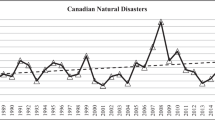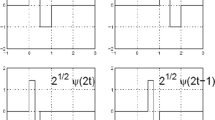Abstract
This study investigates the extreme return connectedness between five major Chinese stock prices and climate uncertainty between March 2010 and June 2022. A novel wavelet time-varying parameter quantile vector Autoregression is employed. The results show that climate uncertainty depresses investment predominantly in normal periods while altering the lead-lag direction among these sector classes during turmoil periods. The results provide significant implications for investors and policymakers concerned with stock prices.





Similar content being viewed by others
Notes
Details can be found at: https://www.iea.org/reports/global-energy-review-2021.
Due to space limitation, the mathematical steps for wavelets methodology are eschewed here, and only the concepts and definitions useful for our purposes are introduced. The reader interested in the theory and use of wavelets may refer to Percival and Walden (2000).
Due to space limitation, only the results of the short run estimation are presented here. Other frequencies are available upon request.
For robustness checks, we estimate the W-TVP-QVAR model with 5-, 15-, and 24-step-ahead GFEVD, and we conduct the above analyses using an alternative quantile. The results from the alternative inputs and model settings are qualitatively similar and available upon request.
References
Alfieri, L., Feyen, L., Di Baldassarre, G.: Increasing flood risk under climate change: A pan-european assessment of the benefits of four adaptation strategies. Clim. Change 136(3), 507–521 (2016)
Alshater, M.M., Alqaralleh, H., El Khoury, R.: Dynamic asymmetric connectedness in technological sectors. J. Econ. Asym. 27, e00287 (2023)
Ando, T., Greenwood-Nimmo, M., Shin, Y.: Quantile connectedness: Modeling tail behavior in the topology of financial networks. Manag. Sci. 68(4), 2401–2431 (2022)
Baek, S., Mohanty, S.K., Glambosky, M.: COVID-19 and stock market volatility: An industry level analysis. Finance Res. Lett. 37, 101748 (2020)
Baumöhl, E., Shahzad, S.J.H.: Quantile coherency networks of international stock markets. Finance Res. Lett 31, 119–129 (2019)
Bloom, N.: The impact of uncertainty shocks. Econometrica 77(3), 623–685 (2009)
Bolton, P., Despres, M., Da Silva, L.A.P., Samama, F., Svartzman, R.: The Green swan. BIS Books (2020)
Bouri, E., Cepni, O., Gabauer, D., Gupta, R.: Return connectedness across asset classes around the COVID-19 outbreak. Int. Rev. Financial Anal. 73, 101646 (2021)
Bown, C.P.: The 2018 US-China trade conflict after forty years of special protection. Chin. Econ. J. 12(2), 109–136 (2019)
Broadstock, D.C., Chan, K., Cheng, L.T., Wang, X.: The role of ESG performance during times of financial crisis: Evidence from COVID-19 in China. Finance Res. Lett. 38, p.101716. (2021)
Cao, G., Xie, W.: Asymmetric dynamic spillover effect between cryptocurrency and China's financial market: Evidence from TVP-VAR based connectedness approach. Finance Res. Lett. 49, 103070 (2022)
Chen, Z., Zhang, L., Weng, C.: Does climate policy uncertainty affect chinese stock market volatility? Int. Rev. Econ. Finance. 84, 369–381 (2023)
Clapp, C., Lund, H.F., Aamaas, B., Lannoo, E.: Shades of climate risk. Categorising climate risk for Investors. CICERO report (2017)
D’Orazio, P.: Towards a post-pandemic policy framework to manage climate-related financial risks and resilience. Clim. Policy. 21(10), 1368–1382 (2021)
Diaz-Rainey, I., Gehricke, S.A., Roberts, H., Zhang, R.: Trump vs. Paris: The impact of climate policy on US listed oil and gas firm returns and volatility. Int. Rev. Financial Anal. 76, 101746 (2021)
Dunz, N., Naqvi, A., Monasterolo, I.: Climate sentiments, transition risk, and financial stability in a stock-flow consistent model. J. Financial Stab. 54, 100872 (2021)
Fang, Y., Jing, Z., Shi, Y., Zhao, Y.: Financial spillovers and spillbacks: New evidence from China and G7 countries. Econ. Model. 94, 184–200 (2021)
Gavriilidis, K.: Measuring climate policy uncertainty. Available at SSRN 3847388. (2021)
Giglio, S., Kelly, B., Stroebel, J.: Climate finance. Annual Rev. Financial Econ. 13, 15–36 (2021a)
Giglio, S., Maggiori, M., Rao, K., Stroebel, J., Weber, A.: Climate change and long-run discount rates: Evidence from real estate. Rev. Financial Stud. 34(8), 3527–3571 (2021b)
Hanif, W., Hernandez, J.A., Mensi, W., Kang, S.H., Uddin, G.S., Yoon, S.M.: Nonlinear dependence and connectedness between clean/renewable energy sector equity and European emission allowance prices. Energy Econ., 101, p.105409. (2021)
He, M., Zhang, Y.: Climate policy uncertainty and the stock return predictability of the oil industry. J.Int. Financial Mark., Inst. Money, 81, p.101675. (2022)
Hsu, P.H., Li, K., Tsou, C.Y.: The pollution premium. J. Finance, Forthcoming. (2022)
Karydas, C., Xepapadeas, A.: Climate change financial risks: Implications for asset pricing and interest rates. J. Financial Stab., p.101061. (2022)
Kettunen, J., Bunn, D.W., Blyth, W.: Investment propensities under carbon policy uncertainty. Energy J., 32(1). (2011)
Khalfaoui, R., Mefteh-Wali, S., Viviani, J.L., Jabeur, S.B., Abedin, M.Z., Lucey, B.M.: How do climate risk and clean energy spillovers, and uncertainty affect US stock markets?. Technol. Forecast. Soc. Change, 185, p.122083. (2022)
Lee, K., Cho, J.: Measuring Chinese Climate Uncertainty. Available at SSRN 4123659. (2022)
Li, H., Xu, X.L., Dai, D.W., Huang, Z.Y., Ma, Z., Guan, Y.J.: Air pollution and temperature are associated with increased COVID-19 incidence: A time series study. Int. J. Infect. Dis. 97, 278–282 (2020)
Liang, C., Umar, M., Ma, F., Huynh, T.L.: Climate policy uncertainty and world renewable energy index volatility forecasting. Technol. Forecast. Soc. Change, 182, p.121810. (2022)
Lv, W., Li, B.: Climate policy uncertainty and stock market volatility: Evidence from different sectors. Finance Res. Lett., 51, p.103506. (2023)
Nordhaus, W.D., Yang, Z.: A regional dynamic general-equilibrium model of alternative climate-change strategies. Am. Econ. Rev., pp.741–765. (1996)
Percival, D.B., Walden, A.T.: Wavelet Methods for time Series Analysis, vol. 4. Cambridge university press (2000)
Ren, X., Li, Y., Shahbaz, M., Dong, K., Lu, Z.: Climate risk and corporate environmental performance: Empirical evidence from China. Sustainable Prod. Consum. 30, 467–477 (2022)
Schoenmaker, D.: Greening monetary policy. Clim. Policy. 21(4), 581–592 (2021)
Stolbova, V., Monasterolo, I., Battiston, S.: A financial macro-network approach to climate policy evaluation. Ecol. Econ. 149, 239–253 (2018)
Su, X.: Measuring extreme risk spillovers across international stock markets: A quantile variance decomposition analysis. North Am. J. Econ. Finance, 51, p.101098. (2020)
Svartzman, R., Bolton, P., Despres, M., Da Silva, P., L.A. and, Samama, F.: Central banks, financial stability and policy coordination in the age of climate uncertainty: A three-layered analytical and operational framework. Clim. Policy. 21(4), 563–580 (2021)
Wang, J., Ma, F., Bouri, E., Zhong, J.: Volatility of clean energy and natural gas, uncertainty indices, and global economic conditions. Energy Econ., 108, p.105904. (2022)
Xu, Y., Wang, J., Chen, Z., Liang, C.: Economic policy uncertainty and stock market returns: New evidence. North Am. J. Econ. Finance, 58, p.101525. (2021)
Xu, Y., Li, M., Yan, W., Bai, J.: Predictability of the renewable energy market returns: The informational gains from the climate policy uncertainty. Resour. Policy, 79, p.103141. (2022)
Zeng, Q., Ma, F., Lu, X., Xu, W.: Policy uncertainty and carbon neutrality: Evidence from China. Finance Res. Lett., p.102771. (2022)
Zhai, P., Zhou, B., Chen, Y.: A review of climate change attribution studies. J. meteorological Res. 32(5), 671–692 (2018)
Author information
Authors and Affiliations
Corresponding author
Additional information
Publisher’s Note
Springer Nature remains neutral with regard to jurisdictional claims in published maps and institutional affiliations.
Rights and permissions
Springer Nature or its licensor (e.g. a society or other partner) holds exclusive rights to this article under a publishing agreement with the author(s) or other rightsholder(s); author self-archiving of the accepted manuscript version of this article is solely governed by the terms of such publishing agreement and applicable law.
About this article
Cite this article
Alqaralleh, H.S. The extreme spillover from climate policy uncertainty to the Chinese sector stock market: wavelet time-varying approach. Lett Spat Resour Sci 16, 31 (2023). https://doi.org/10.1007/s12076-023-00352-w
Received:
Accepted:
Published:
DOI: https://doi.org/10.1007/s12076-023-00352-w




